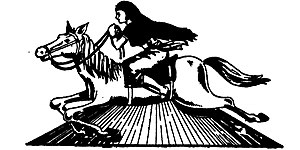Marjing
| Marjing | |
|---|---|
| Member of Divine polo players | |
 God Marjing riding on Samaton, the winged horse | |
| Other names | Marching, Ibudhou Marjing, Ebudhou Marjing, Iputhou Marjing, Eputhou Marjing |
| Affiliation | Meitei mythology (Manipuri mythology) and Meitei religion (Sanamahism) |
| Major cult center | Heingang Hills |
| Abode | Heingang Hills |
| Weapon | Kangjei (Polostick) |
| Artifacts | Kangjei (Polostick) |
| Animals | Horses[1][4] |
| Mount | Samadon Ayangba (Old Manipuri: Samaton Ayangpa) |
| Texts | Kangjeirol, Leithak Leikharol |
| Gender | Male |
| Region | Ancient Kangleipak (Antique Manipur) |
| Ethnic group | Meitei ethnicity |
| Festivals | Lai Haraoba |
| Personal information | |
| Consort | Humu Leima |
| Offspring | Tolongkhomba (or Loyalakpa in other stories) |
| Dynasty | Chenglei dynasty[5] |
| Equivalents | |
| Greek equivalent | Ares |
| Norse equivalent | Odin |
Marjing (Meitei: ꯃꯥꯔꯖꯤꯡ) is a primordial deity in Meitei mythology and religion of Ancient Kangleipak (Antique Manipur). He is the God of horses, polo, hockey, sports and war.[6][7][8][9] The guardianship of the north eastern direction is alluded to Marjing and the other directions to Koubru (north west), Thangjing (south west) and Wangbren (south east).[10][11][12][13] According to the legend, he invented the game of polo (Sagol Kangjei) and introduced it as the national game.[2][3][10][14][15] He and his divine creature, Samadon Ayangba, reside in the top of the Heingang hills.[16]
Origin[edit]
According to the Leithak Leikharol PuYa, God Marjing (mentioned as "Maraching") originated from the intestines of Atiya Sidaba. He was created to control Samadon Ayangba, the divine horse (Old Manipuri: Sakon). The horse was created from the foot of Ashiba (Sanamahi).[17]
Description[edit]
God Marjing is one of the five gods who enter into the human body and position themselves as one of the souls.[17][18] Marjing dwells in the heart of human body.[19] The God is also associated with Sagol Kangjei (Polo), the main sports of the Meitei people. Parratt says "His main importance in Meitei mythology is that he is credited with the invention of polo, the national game."[17][18][20]
Mythology[edit]
Sagol Kangjei (English: Polo) is originally the game of gods. There are 7 players on each side. They used Kangdrum (a ball made from bamboo root). This is what the human beings imitate from them. The first divine polo match was played during the festival of Lai Haraoba.[20]
Worship[edit]
During the Lai Haraoba festival, a maibi (priestess) performs a ritual in the form of a mime. She holds a mallet in her hand and enacts the game of polo.[7]
Every year, in the top of the Heingang Hills, devotees offer polostick (Old Manipuri: ꯀꯥꯡꯆꯩ, romanized: kangchei, Meitei: ꯀꯥꯡꯖꯩ, romanized: kangjei) and bamboo-root-ball (Meitei: ꯀꯥꯡꯗ꯭ꯔꯨꯝ, romanized: kangdrum) to God Marjing.[20] This is done even when any animal in one's house become sick.[9]
In 1618 AD, during the reign of King Khagemba, a public worship took place at his abode and also at every watery place on the river side. Wild boars, ducks, cocks, hen, pigeons and other creatures were offered to God Marjing. This was recorded in the Cheitharol Kumbaba.[20][21][22]
Related pages[edit]
References[edit]
- ↑ 1.0 1.1 Mārg̲. Marg Publications. 1960.
- ↑ 2.0 2.1 Lightfoot, Louise (1958). Dance-rituals of Manipur, India: An Introduction to "Meitei Jagoi". Ministry of Scientific Research and Cultural Affairs. ISBN 978-1-01-374640-6.
- ↑ 3.0 3.1 Anvīkshā. Jadavpur University. 2004.
- ↑ Singh, Moirangthem Kirti (1988). Religion and Culture of Manipur. Manas Publications. ISBN 978-81-7049-021-0.
- ↑ Levin, Jonathan V. (2017-10-04). Where Have All the Horses Gone?: How Advancing Technology Swept American Horses from the Road, the Farm, the Range and the Battlefield. McFarland. ISBN 978-1-4766-6713-3.
- ↑ Saraswati, Baidyanath (1991). Tribal Thought and Culture: Essays in Honour of Surajit Chandra Sinha. Concept Publishing Company. ISBN 978-81-7022-340-5.
- ↑ 7.0 7.1 Bhattacharjee, Kishalay (2013-04-11). Che in Paona Bazar. Pan Macmillan. ISBN 978-1-4472-4741-8.
- ↑ Fløistad, Guttorm (2012-12-06). Philosophie asiatique/Asian philosophy. Springer Science & Business Media. ISBN 978-94-011-2510-9.
- ↑ 9.0 9.1 Vijaylakshmi Brara, N. (1998). Politics, society, and cosmology in India's North East. p. 148. ISBN 978-0-19-564331-2.
{{cite book}}:|website=ignored (help) - ↑ 10.0 10.1 Devi, Dr Yumlembam Gopi. Glimpses of Manipuri Culture. Lulu.com. ISBN 978-0-359-72919-7.
- ↑ Mārg̲. Marg Publications. 1960.
- ↑ Muthukumaraswamy, M. D.; Kaushal, Molly (2004). Folklore, Public Sphere, and Civil Society. NFSC www.indianfolklore.org. ISBN 978-81-901481-4-6.
- ↑ Dzüvichü, Lipokmar; Baruah, Manjeet (2017-11-13). Modern Practices in North East India: History, Culture, Representation. Taylor & Francis. ISBN 978-1-351-27134-9.
- ↑ Singh, Moirangthem Kirti (1998). Recent Researches in Oriental Indological Studies: Including Meiteilogy. Parimal Publications.
- ↑ Singh, Dr Th Suresh (2014-06-02). The Endless Kabaw Valley: British Created Visious Cycle of Manipur, Burma and India. Quills Ink Publishing. ISBN 978-93-84318-00-0.
- ↑ "Manipur's female polo players are riding up a storm". e-pao.net.
- ↑ 17.0 17.1 17.2 A Critical Study Of The Religious Philosophy. August 1991. p. 57.
{{cite book}}:|website=ignored (help) - ↑ 18.0 18.1 Vijaylakshmi Brara, N. (1998). Politics, society, and cosmology in India's North East. p. 48. ISBN 978-0-19-564331-2.
{{cite book}}:|website=ignored (help) - ↑ Vijaylakshmi Brara, N. (1998). Politics, society, and cosmology in India's North East. p. 152. ISBN 978-0-19-564331-2.
{{cite book}}:|website=ignored (help) - ↑ 20.0 20.1 20.2 20.3 A Critical Study Of The Religious Philosophy. August 1991. p. 59.
{{cite book}}:|website=ignored (help) - ↑ Religion Of Manipur. 1980. p. 31.
{{cite book}}:|website=ignored (help) - ↑ Religion Of Manipur. 1980. p. 121.
{{cite book}}:|website=ignored (help)
Other websites[edit]
